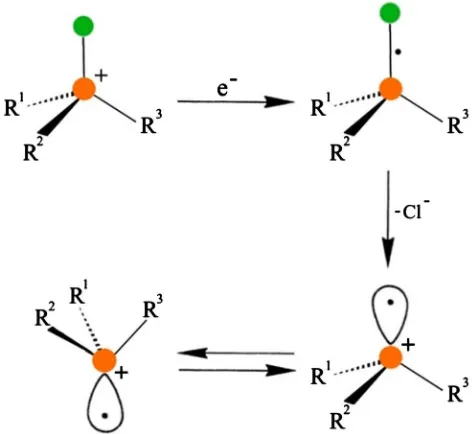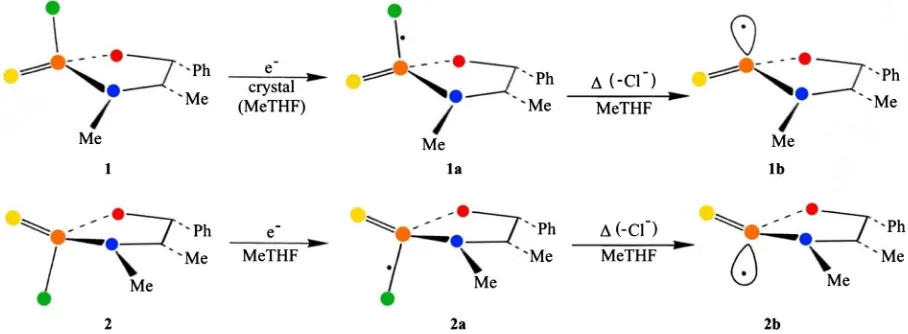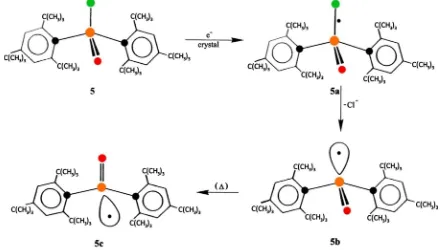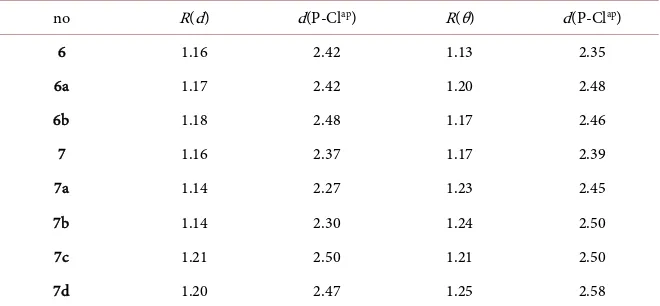ISSN Online: 2162-1977 ISSN Print: 2162-1969
DOI: 10.4236/ojpc.2019.93010 Aug. 30, 2019 182 Open Journal of Physical Chemistry
One-Electron-Addition to Pentavalent
Phosphorus with the Phosphorus-Chlorine
Bond as Acceptor Introducing a Fundamental
Distinction in Substitution Mechanism
between S
N
2(P) and S
N
2(C)
Henk M. Buck
Kasteel Twikkelerf 94, Tilburg, The Netherlands
Abstract
An electron-addition, under single-crystal conditions, to pentavalent phospho-rus compounds as Cl-P (=O, S) Y, Z with the P-Cl bond as electron-accepting group, is selected as an additional model for SN2(P) like reactions. It is
demonstrated that the geometric information stored in the tetrahedral confi-guration (substrate) can be transmitted in the corresponding trigonal bipy-ramidal (TBP) state for nucleophilic substitution. In this article, we focus on these specific mechanistic aspects of carbon and phosphorus. We consider our study as a contribution to the significance of these (bio)chemical inter-mediates.
Keywords
Pentavalent Phosphorus and Carbon Compounds, σ*-Electron-Addition, Single-Crystal Electron Spin Resonance (ESR), Model and Ab Initio Calculations, Differences in SN2(C) vs. SN2(P) Mechanism
1. Introduction
Our research has correspondence with nucleophilic phosphorus inversion using the smallest nucleophilic agent (e−). We focused on pentavalent phosphorus
compounds Cl-P (=O, S) Y, Z with an electron-accepting P-Cl linkage. The rad-icals, established with electron spin resonance (ESR) spectroscopy were obtained with single-crystal, powered and host-matrix x-irradiation at low temperature
How to cite this paper: Buck, H.M. (2019) One-Electron-Addition to Pentava-lent Phosphorus with the Phosphorus-Chlo- rine Bond as Acceptor Introducing a Fun-damental Distinction in Substitution Me-chanism between SN2(P) and SN2(C). Open Journal of Physical Chemistry, 9, 182-191.
https://doi.org/10.4236/ojpc.2019.93010
Received: July 29, 2019 Accepted: August 27, 2019 Published: August 30, 2019
Copyright © 2019 by author(s) and Scientific Research Publishing Inc. This work is licensed under the Creative Commons Attribution International License (CC BY 4.0).
http://creativecommons.org/licenses/by/4.0/
DOI: 10.4236/ojpc.2019.93010 183 Open Journal of Physical Chemistry [1] [2] [3]. With the dissociation of Cl−, the inverted phosphorus-centered
radi-cal can be formed. From the single-crystal studies, it could be established that inter-molecular interactions play a dominant role in the adjustment of the ste-reochemically controlled electron-addition preference. In fact, these reactions are closely related to Single Electron Transfer (SET) reactions [4].
One-electron-addition accompanied with inversion is shown for a phospho-nium cation R1R2R3 P+-Cl in Figure 1.
The essential step in Figure 1 is the dissociation of the chloride anion, after electron-addition at the σ*-antibonding orbital of the P-Cl bond, resulting in the formation of the tetravalent phosphorus-centered radical. The inversion barrier of tetravalent substituted phosphines (R3P:) and their corresponding cationic
phosphorus radicals (R3P•+) has been described by Creve and Nguyen for simple
systems with ab initio MO and DFT calculations [5]. In radical cations, the in-version barriers are consistently and substantially reduced compared with the neutral ones. In fact, we are dealing with a dissociative electron transfer attach-ment to a molecule with a potentially cleavable bond.
Recently, a study of Nikitin et al. [6] was published on the direct observa-tion of the stereochemical inversion of phosphorus in an SN2(P) reaction via
a trigonal bipyramidal (TBP) geometry based on the conventional mechan-ism. The fluxional interconversions between otherwise very similar bromides and chlorides [R3P+-X] X− (R = Alkyl, Aryl; X = Cl, Br) were studied with
NMR techniques. The energy barriers are 11 kcal/mol but rise rapidly as bulky groups are substituted at phosphorus revealing the effect of intra-molecular interactions.
[image:2.595.254.491.477.694.2]Experimental support for our model description is given in the next section. Three closely related substrates are given under 2.1., 2.2. and 2.3.
Figure 1. Electron-addition of the phosphonium cation R1R2R3 P+-Cl and the
DOI: 10.4236/ojpc.2019.93010 184 Open Journal of Physical Chemistry
2. Experimental Results and Discussion
2.1. Electron-Addition at 2R, 4S, 5R and 2S, 4S, 5R Stereoisomers of 2-Chloro-3,4di-Methyl-5-Phenyl-1,3,2-Oxaza
Phospholidine-2-Sulphide
The x-ray irradiation of the 2R, 4S, 5R (1) and 2S, 4S, 5R (2) substrates was car-ried out under single-crystal conditions and low temperature at 77 K resulting in a high yield and corresponding strong ESR absorptions at 105 K of 1a and a very weak ESR signal of 2a suggesting the impact of geometric inter-molecular inte-ractions. The preparation and molecular structure determination of 1 and 2, their corresponding radical anions and phosphorus-centered radicals are de-scribed in Ref. [1].
The inter-molecular interactions could be eliminated by using a host matrix as frozen 2-methyl-tetrahydrofuran (MeTHF). In Figure 2 the electron-addition products 1a and 2 a are given with their corresponding phosphorus radicals 1b and 2b respectively.
From representation of the precursors 1 and 2 in the crystal lattice it could be concluded that the shortest interaction of 1 reaches higher values than its isomer 2. This means that increase of the P-Cl bond after electron-addition will be bet-ter accommodated in 1. In a host matrix as MeTHF this selection is absent. Rad-ical 1a can be detected in the crystal for temperatures up to 225 K, demonstrat-ing its thermal stability. In the MeTHF matrix at 115 K a fast conversion of 1a into 1b takes place demonstrating the effect of the molecular environment. This means that specific atomic movements in the crystal, even the Cl− dissociation,
are hindered by the rigidity imposed by the molecular setting. This is certainly the case for the inversion of the phosphorus-centered radicals (1b, 2b).
[image:3.595.85.539.505.672.2]2.2. Electron-Addition at Di(Pyrrolidino) Chloro Phosphine Sulphide The specificity for electron-addition of the P-Cl bond has also been observed for
Figure 2. The electron-addition products of 1 and 2 are given with the odd electron localized in the σ*-antibonding orbital of the P-Cl bond (1a and 2a, respectively) and the phosphorus-centered radicals (1b and 2b, respectively) under thermal dissociation of Cl−. The electron-addition takes place under x-irradiation at low temperature at 77 K and the ESR spectra
DOI: 10.4236/ojpc.2019.93010 185 Open Journal of Physical Chemistry the related di(pyrrolidino)chlorophosphine sulphide 3 shown in Figure 3 under the same experimental conditions as for the aforementioned compound 1 [2].
For these related electron-addition radicals the ratio of the spin densities on phosphorus and chlorine is between three and four. This preference for localiza-tion of the extra electron on phosphorus directs the dissocialocaliza-tion towards Cl−.
[image:4.595.118.538.429.524.2]Generally, the backside attack of the nucleophile or electron is in favor of the frontside attack. However, substitution of chlorine by fluorine results in frontside attack [2]. The selected compound di(morpholino)fluorophosphine sulphide 4 is closely related to the latter one. The preparation and molecular structure determination of 3 and 4, their corresponding radical anions and phosphorus-centered radicals are described in Ref. [2]. The results are given in Figure 3 and Figure 4.
2.3. Electron Addition at Bis (2,4,6-tri-t-ButylPhenyl) Phosphinic Chloride
Electron-addition followed in-line with the phosphorus-centered radical under inversion of its tetrahedral configuration was observed for the single-crystal electron-addition of bis (2,4,6-tri-t-butylphenyl)phosphinic chloride. The prepara-tion and molecular structure determinaprepara-tion of 5 and the phosphorus-centered radicals are described in Ref. [3]. This result is given in Figure 5.
[image:4.595.129.538.580.671.2]From the ESR experiments it is clear that 5b shows a direct enantioselective stereo-inversion into 5c. In fact, this is the right example to show the unique process procedure in a coupled electron transfer resulting in inversion of the
Figure 3. Electron-addition of di(pyrrolidino)chlorophosphine sulphide 3 with the odd electron localized in the σ*-antibonding orbital of the P-Cl bond (3a) and the phosphorus-centered radical 3b under thermal dis-sociation of Cl−.
Figure 4. Electron-addition of di(morpholino)fluorophosphine sulphide 4 with the odd electron in an equa-torial position of the trigonal bipyramid (TBP-e) and fluorine and sulphur, carrier of the negative charge, in apical positions (4a). Electron displacement in the axis of the TBP results in dissociation of F−and the
DOI: 10.4236/ojpc.2019.93010 186 Open Journal of Physical Chemistry
Figure 5. The electron-addition product of 5 with the odd electron localized in the σ*-antibonding orbital of the P-Cl bond 5a and the phosphorus-centered radical 5b under dissociation of Cl−. The electron-addition takes place with
x-irradiation at low temperature at 77 K. At 100 K 5b (dominant) and 5c (minor) are present. On slow thermal annealing 5b rapidly disappears with a simultaneous increase of 5c.
tetrahedral phosphorus configuration. This inversion is determined by well-defined intra- and inter-molecular interactions and orientations (influence of the t-butyl groups) under single-crystal condition.
It is suggested that the stereo-inversion occurs in a synchronous reorientation of the P-O bond. This conversion is favored by relieve of steric strain in the crystal by relocation of the P-O bond to the vacant chlorine space. We consider this unique bond relocation as an example of spatial coordination. This mecha-nistic mode is an intrinsic property (inversion) of the radical that is triggered by a synchronous Cl− release.
3. Three-Electron Bonding as a Specific Local Site in the
Various Substrates under Investigation
3.1. Introduction
DOI: 10.4236/ojpc.2019.93010 187 Open Journal of Physical Chemistry [7] [8]. In the case of a linear 3-center configuration we used the principal reac-tion coordinate of a tetrahedral arrangement for the formareac-tion of a TBP transi-tion complex. For the number of electrons (2, 3 and 4) in these transitransi-tions, the corresponding ratio numbers are 1.167, 1.250, and 1.333. This means that these ratio numbers have no restrictions in their application concerning the migrating particle. As an example for the 3-center 4-electron TS we selected the SN2
me-chanism simplified by the identity substitution reaction:
[
]
(
)
3 3 3
X−+CH -X→ X-CH -X− →X-CH +X− X=halogen
In this case, the positively charged methyl migrates between the negatively charged halogens. The TS can then be characterized as a TBP configuration with X in apical positions. In the most ideal (tetrahedral) configuration, the ratio number for the TS i.e., the ratio between the apical distance and the corres-ponding bond length in the initial state is 1.333 (=1-cos 109.47˚) or 1 + n/12 with n = 4, the number of electrons. These ratio numbers are indicated as R(d), R(θ), and R(n), respectively.
A similar result is obtained for the linear proton transfer between carbanions. In that case one is dealing with a divalent hydrogen and in the former case with a pentavalent carbon [7] [8]. The different aspects are supported by ab initio calculations.
The distances d1,2 =d2,3 for the symmetrically transitional 3-center interme-diates can be generally described with:
(
)
( )1,2 2,3 , , 1,2 2,3
d =d =R dθ n ×d
in which d1,2 2,3( ) are the initial bond distances.
3.2. Odd Electron Localized in the σ*-Antibonding Orbital of the Three-Electron P-Cl Bond
We consider the acceptor with the odd electron in the σ*-antibonding orbital of the P-Cl bond as a three-center three-electron bonding system. As an example we take the radical anion 1a in Figure 1. With the experimental spin densities of P and Cl, the ratio number R(n) can then be written as:
( )
1 2{
s,p( )
P s.p( )
Cl}
1 12R n = + + ρ +ρ
The sum of the spin density (ρ) on P and Cl is 0.769 (P 0.577 and Cl 0.192) with R(n) is 1.231 resulting in a P-Cl distance of 2.519 Å using 2.047 Å for the initial bond [1]. The increase of the P-Cl bond is 0.47 Å and for the dissocia-tion of Cl− 0.57 Å is requested which is in accordance with the favored
elec-tron-addition at 2R, 4S, 5R stereoisomer of 2-chloro-3,4 dimethyl-5-phenyl-1,3,2- oxazaphospholidine-2-sulphide with regards to its 2S, 4S, 5R stereoisomer as shown in Figure 1.
A related example can be given for the electron capture of an x-irradiated single crystal di(pentavalent-phosphine) disulphide [9] as:
( ) ( )
2 2
R P S -P S R −
DOI: 10.4236/ojpc.2019.93010 188 Open Journal of Physical Chemistry The sum of the spin densities of phosphorus is 0.816 (0.840), 0.870, and 0.830 with corresponding R(n) values of 1.23 (5), 1.23 (7), 1.23 (9), and 1.23 (6). The first two values correspond with two sets of the R = Me precursors with P-P dis-tances of 2.245 and 2.165 Å, respectively. Electron-addition results in disdis-tances of 2.773 and 2.678 Å. Ab initio calculations for R = H give 2.726 Å [9].
A few years ago an x-ray crystal study of an S-S three-electron σ-bond was published with an S-S distance of 2.817 Å for the cis-parallel phenyl substituents and 2.757 Å for the trans-conformer [10]. Unfortunately, the experimental S-S distance for the dictations is unknown. With the theoretical value of 2.187 Å for [H2S-SH2]2+ [11] we obtain for R(d) 1.28 (8) and 1.26 (1) respectively. For the
Se-Se three-electron σ-bond with cis-parallel phenyl substituents 2.942 Å was established [12]. Using the experimental Se+-Se+ distance of 2.382 Å [13] the
R(d)-value is 1.23 (5).
It may be of interest to compare these results with the extensively studied identity 3-center 4-electron SN2 (P) conversions [14]. The results are given in the
next section.
3.3. Identity 3-Center 4-Electron SN2(P) Conversions
The results for this type of conversions are given in Figure 6. The data and geo-metric structures were obtained from Van Bochove et al. [14].
Clearly, the highest values for R(d) correspond with 7c and 7d indicated as TS. In fact these R(d) values approach 1.25. So, we decided to use the other ex-pression R(θ) = 1 − cosθ. The information stored in the tetrahedral structure can be converted in its corresponding TBP geometry as demonstrated for the SN2 (C)
[image:7.595.188.539.458.681.2]for halogen (X) exchange, vide supra, in Table 1 [7] [8].
Figure 6.TBP structures of stationary points for SN2 (P) in Å. R(d) values derived from the
ra-tio of the apical distances and corresponding tetrahedral distances (Supporting Informara-tion
DOI: 10.4236/ojpc.2019.93010 189 Open Journal of Physical Chemistry From the results we may conclude that the values of R(d) and R(θ) are close together. A similar procedure can be followed for the identity chloride exchange SN2 (P) in Figure 6. The results are given in Table 2.
For the selected (tetrahedral) choice of θ (ClPX) we took profit of the mir-ror-plane symmetry with excluding θ (ClP = O) and θ (ClP:). In fact there is a good correspondence between R(d) and R(θ). The deviations are found for 7a and 7b. The selection based on the energy profile of the reaction coordinate is opaque because of sufficient lack of information for a definite choice between TC and TS. Interestingly, the difference between the maximum values R(d) and R(θ) in the case of the SN2(C) and the SN2(P) is 1.33 and 1.25, respectively. Using the
[image:8.595.207.540.342.446.2]expression R(n) = 1 + n/12 with n the number of electrons in the three-center bonding for the transition states of both conversions results in four and three electrons, respectively. We suggest that in the latter case the first step may be described as a one-electron transfer accommodated by the P-Cl site (see the reac-tion scheme as given in Figure 1). This means that the latter process undergoes
Table 1. A comparison between R(d)a and R(θ)bvalues in combination with the
pentava-lent carbon state [XCH3X]−.
Halogen Method Ab initioa Modelingb,c
X Level d(C(V)-X) d(C(IV)-X) R(d) R(θ) d(C(IV)-X) d(C(V)-X) F ZORA-OLYP/TZ2P 1.860 1.396 1.332 1.322 1.383 1.828 Cl ZORA-OLYP/TZ2P 2.360 1.791 1.318 1.319 1.776 2.343 Br ZORA-OLYP/TZ2P 2.510 1.959 1.281 1.304 1.934 2.522 I ZORA-OLYP/TZ2P 2.720 2.157 1.261 1.319 2.132 2.812
aR d( )=d(C V -X( ) ) d(C IV -X( ) ). The distances (d) are in Å. bThe R(θ) values from experimental angle (θ) data of the tetrahedral structures using R(θ) = 1 − cosθ. cThe corresponding values for the pentavalent state are obtained with d(C V -X( ) )=R( )θ ×d(C IV -X( ) ) using the experimental distances of the
[image:8.595.209.539.531.684.2]tetra-hedral structures.
Table 2. Comparison of R(d) and R(θ) of the stationary points in Figure 6.
no R(d) d(P-Clap) R(θ) d(P-Clap)
6 1.16 2.42 1.13 2.35
6a 1.17 2.42 1.20 2.48
6b 1.18 2.48 1.17 2.46
7 1.16 2.37 1.17 2.39
7a 1.14 2.27 1.23 2.45
7b 1.14 2.30 1.24 2.50
7c 1.21 2.50 1.21 2.50
7d 1.20 2.47 1.25 2.58
The corresponding R(θ) values are obtained from the theoretical angle data (θ) of selected tetrahedral con-figurations (Supporting Information [14]). The P-Clap distance in the last column is obtained using R(θ) × d
DOI: 10.4236/ojpc.2019.93010 190 Open Journal of Physical Chemistry conversion into the phosphorus-centered radical after dissociation of Cl−with
inversion of phosphorus accompanied by P-Cl bond formation. Finally, we think that the selected tetrahedral value θ (ClPX) determines the choice of the reaction coordinate in the SN2(P).
4. Conclusion
The basic principle of SN2 reactions is that they are bimolecular and occur with
inversion of configuration at the reacting atom as demonstrated for carbon. The TS can be described as TBP with incoming nucleophile and leaving group in apical positions. Generally, this model description has been also applied to phosphorus. However, our study shows theoretically fundamental differences between SN2(C) and SN2(P) substitution reactions with regard to the
participa-tion of the number of electrons in the TS.
Acknowledgements
I thank Professor Dr. Kirill Nikitin, School of Chemistry University of Dublin, for his valuable discussions.
My grandson Robin van Dorrestein for his technical assistance.
Conflicts of Interest
The author declares no conflicts of interest regarding the publication of this paper.
References
[1] Aagaard, O.M., Janssen, R.A.J., DeWaal, B.F.M. and Buck, H.M. (1990) Intermole-cular Effects on the Radiogenic Formation of Electron-Capture Phospho-rus-Centered Radicals. A Single-Crystal ESR Study of Diastereoisomeric Precursors.
Journal of the American Chemical Society,112, 938-944. https://doi.org/10.1021/ja00159a005
[2] Janssen, R.A.J., Sonnemans, M.H.W. and Buck, H.M. (1986) The σ* and TBP-e Radicals Obtained by Electron Capture of Four-Coordinated Phosphorus Com-pounds. A Single-Crystal ESR Study. Journal of the American Chemical Society, 108, 6145-6149.https://doi.org/10.1021/ja00280a006
[3] De Waal, B.F.M., Aagaard, O.M. and Janssen, R.A.J. (1991) Enantioselective Inver-sion of a Chiral Phosphoryl Radical. A Single-Crystal ESR Analysis of X-Irradiated Bis(2,4,6-tri-tert-butylphenyl)phosphinic Chloride. Journal of the American Chem-ical Society, 113, 9471-9479.https://doi.org/10.1021/ja00025a008
[4] Uchiyama, N., Shirakawa, E. and Hayashi, T. (2013) Single Electron Trans-fer-Induced Grignard Cross-Coupling Involving Ion Radicals as Exclusive Interme-diates. Chemical Communications, 49, 364-366.
https://doi.org/10.1039/C2CC37643A
[5] Creve, S. and Nguyen, M.T. (1998) Inversion Processes in Phosphines and Their Related Cations: When Is a Pseudo-Jahn-Teller Effect Operative? Journal of Physi-cal Chemistry A, 102, 6549-6557.https://doi.org/10.1021/jp981083x
Dy-DOI: 10.4236/ojpc.2019.93010 191 Open Journal of Physical Chemistry
namic Cross-Exchange in Halophosphonium Species: Direct Observation of Ste-reochemical Inversion in the Course of an SN2 Process. Angewandte Chemie
Inter-national Edition, 57, 1480-1484.https://doi.org/10.1002/anie.201708649
[7] Buck, H.M. (2008) A Combined Experimental, Theoretical, and Van’t Hoff Model Study for Identity Methyl, Proton, Hydrogen Atom, and Hydride Exchange Reac-tions. International Journal of Quantum Chemistry, 108, 1601-1614.
https://doi.org/10.1002/qua.21683
[8] Buck, H.M. (2012) Mechanistic Models for the Intramolecular Hydroxycar-bene-Formaldehyde Conversion and Their Intermolecular Interactions: Theory and Chemistry of Radicals, Mono- and Dications of Hydroxycarbene and Related Con-figurations. International Journal of Quantum Chemistry, 112, 3711-3719. https://doi.org/10.1002/qua.24127
[9] Janssen, R.A.J., Sonnemans, M.H.W. and Buck, H.M. (1986) Electron Capture Phosphoranyl Radicals in X-Irradiated Diphosphine Disulfides. A Single Crystal ESR and Ab Initio Quantum Chemical Study. Journal of Chemical Physics, 84, 3694-3708.https://doi.org/10.1021/ja00226a013
[10] Zhang, S., Wang, X., Sui, Y. and Wang, X. (2014) Odd-Electron-Bonded Sulfur Radical Cations: X-Ray Structural Evidence of a Sulfur-Sulfur Three-Electron
σ-Bond. Journal of the American Chemical Society, 136, 14666-14669. https://doi.org/10.1021/ja507918c
[11] Gill, P.M.W. and Radom, L. (1989) Structures and Stabilities of the Dimers Dica-tions of First- and Second-Row Hydrides. Journal of the American Chemical Socie-ty, 111, 4613-4622.https://doi.org/10.1021/ja00195a014
[12] Zhang, S., Wang, X., Su, Y., Zhang, Z., Qiu, Y. and Wang, X. (2014) Isolation and Reversible Dimerization of a Selenium-Selenium Three-Electron σ-Bond. Nature Communications, 5, Article No. 4127.https://doi.org/10.1038/ncomms5127
[13] Iwasaki, F., Morimoto, M., Yasui, M., Akaishi, R., Fujihara, H. and Furukawa, N. (1991) Structure of 1,5-Diselenoniabicyclo[3.3.0]octane Bis(tetrafluoroborate) Ace-tonitrile Solvate. Acta Crystallographica, C47, 1463-1466.
https://doi.org/10.1107/S0108270190012586
[14] Van Bochove, M.A., Swart, M. and Bickelhaupt, F.M. (2006) Nucleophilic Substitu-tion at Phosphorus (SN2@P): Disappearance and Reappearance of ReacSubstitu-tion Bar-riers. Journal of the American Chemical Society, 128, 10738-10744.




![Figure 6. TBP structures of stationary points for Stio of the apical distances and corresponding tetrahedral distances (Supporting Information[14]N2 (P) in Å](https://thumb-us.123doks.com/thumbv2/123dok_us/8986529.395351/7.595.188.539.458.681/structures-stationary-distances-corresponding-tetrahedral-distances-supporting-information.webp)
